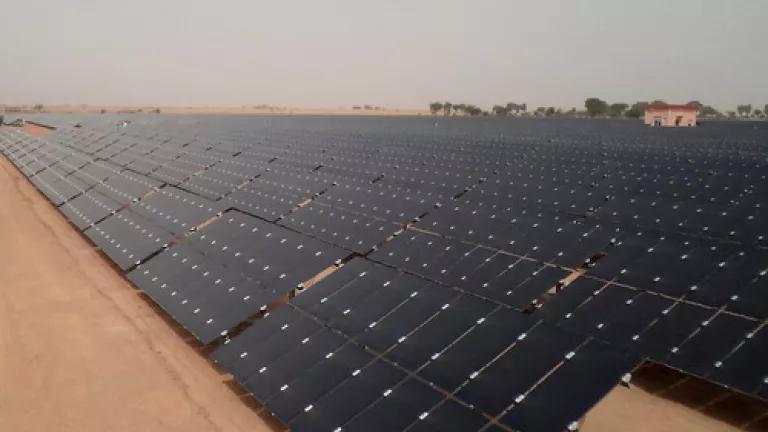
Clean energy received a big boost last week in India when the Ministry of New and Renewable Energy (MNRE) announced an ambitious new target for the next Five Year Plan. India plans to more than double its renewable power capacity to 53,000 megawatts (MW) by 2017. The plan’s specific goal of 10,000 MW of solar in the next five years is good news for the burgeoning Indian solar industry, struggling to gain real traction in a competitive global market.
In order to accomplish this bold target, the government must invest in all aspects of the solar ecosystem. The National Solar Mission (NSM), which concludes its first phase in 2013, and state-level solar programs have effectively launched the nascent solar market, but much more must be done to escalate solar installations across the country.
5 MW grid-connected solar photovoltaic plant developed by Punj Lloyd Infrastructure under the NSM and constructed by Punj Lloyd Delta Renewables in Bap village, Jodhpur, Rajasthan (Photo credit: Punj Lloyd).
MNRE took several steps in the right direction last week when it established a solar advisory council and signed a memorandum of understanding (MOU) for its Solar Energy Centre. India’s new Solar Energy Industry Advisory Council (SEIAC), comprised of leading industrialists, will offer advice to MNRE on how to grow the country’s solar industry through the NSM to make it globally competitive. The thirty-year-old Solar Energy Centre is an MNRE R&D institution that develops solar energy technologies and practices. The new MOU between the Solar Energy Centre and Delhi Technological University creates a Joint Academic Interface Committee dedicated to developing solar technology through research and education programs.
This new advisory council and R&D program will augment MNRE’s ability to nurture the local solar market. However, many other critical issues must also be addressed to accomplish the ambitious solar targets set in the NSM and under the new Five Year Plan. As laid out in our recently released report Laying the Foundation for a Bright Future, written by NRDC and our partner the Council on Energy, Environment and Water (CEEW), particular focus must be paid to incentivizing financing, encouraging local manufacturing, and fostering an enabling environment for solar to thrive in India.
My NRDC colleague, Vignesh Gowrishankar, and our colleague at CEEW, Arunabha Ghosh, have identified the essential recommendations that should be adopted to encourage local solar manufacturing and increase financing for solar projects.
Additionally, our report lays out targeted recommendations to foster an enabling environment for solar technology penetration in India. According to project developers participating in the Solar Mission’s first phase, there are four main causes of delay in implementing grid-connected solar projects in India:
- Land acquisition: Issues related to permitting and siting, rather than the actual cost of land, have delayed new projects from breaking ground. For example, the slow rate at which local authorities convert land use designations from agricultural to non-agricultural and weeding through local claims on land make obtaining permits and clearances difficult.
- Power evacuation: Connecting solar projects to a grid with the requisite capacity, proximity, and availability has proven challenging. The slow pace at which supporting infrastructure can be provided, and whether developers must pay for “last-mile” infrastructure to actually connect projects to the grid also delays commissioning.
- Lack of effective community involvement: Problems arise locally when the community is not engaged throughout the solar project’s installation, which can create contentious conditions for permitting and operating solar projects. Effective involvement of the often village-based neighbors of the sited project can engender greater community acceptance and enthusiasm for solar energy projects.
- Lack of comprehensive NSM implementation plan: A long-term plan that focuses on the entire solar energy supply chain – including R&D, a skilled labor force, and favorable customs and excise duties – is needed to provide certainty for the private sector and communities. At a minimum, government policies must clarify the number and type of projects expected to come online in the future to allow stakeholders to confidently make long-term investments.
As laid out in our report, we have formulated five key recommendations to address these causes for delay and to develop an enabling environment for solar growth:
- The central government should closely and systematically coordinate with state governments on project allotment, land acquisition, and project development, particularly for the larger Phase 2 projects. Specifically, MNRE should work with states to develop effective land allocation strategies for solar projects, including strategies to facilitate siting and planning requirements.
- MNRE should also collaborate closely with the Ministry of Power to plan for transmission infrastructure upgrades within a long-term power planning framework focused on scaling renewable energy.
- Before bidding for Phase 2 projects begins, MNRE and developers should work together to resolve whether last- mile infrastructure costs should be included in project estimates.
- To strengthen solar projects, developers should integrate local communities at the planning stage through regular community meetings and engagement.
- The solar industry should create a network of solar energy groups focused on resolving common industry concerns, interacting with government agencies, developing solutions for the entire solar supply chain, investing in research and development, and increasing the solar energy workforce.
Having initiated growth in the nascent solar industry, the National Solar Mission’s role will now be to strategically prioritize its many objectives to ensure that all the diverse entities within India’s solar ecosystem perform in a coordinated way to establish India as a global leader in solar energy. MNRE is moving in the right direction, and we look forward to working with all of India’s solar stakeholders to continue to the path towards 20,000 MW of solar power by 2022.
